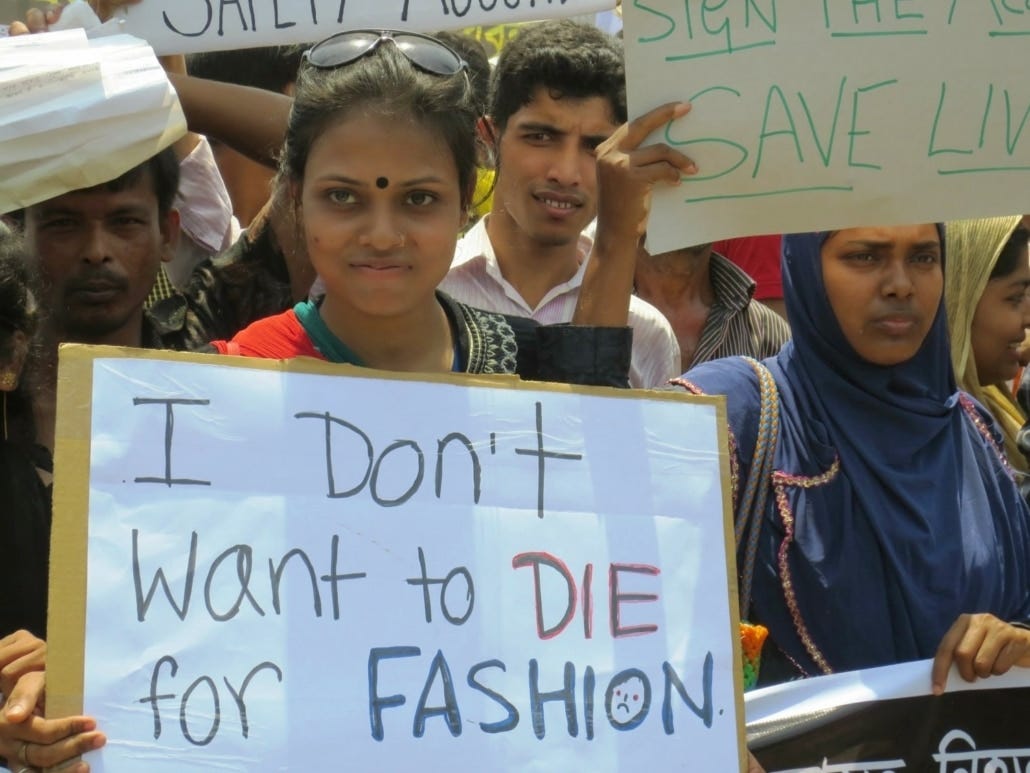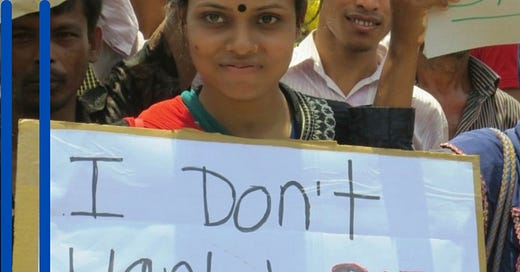In memory of Rana Plaza.
And a significant global majority want governments to do more about climate change.

Twelve years ago yesterday, the Rana Plaza building in Dhaka, Bangladesh, collapsed—an event that remains one of the deadliest structural failures in modern human history. The building housed five garment factories that produced clothes for global brands, ranging from Primark to Prada. When it crumbled on 24 April 2013, it killed 1,134 workers and injured thousands more. Warnings about visible structural cracks had gone unheeded, and garment workers were forced to go inside and work. The catastrophe became a visceral symbol of the hidden cost of fast fashion and prompted a long-overdue reckoning in boardrooms and buying departments around the world.
In the wake of the tragedy, the Bangladesh Accord on Fire and Building Safety was launched, bringing together more than 200 brands, unions, and NGOs to oversee factory inspections and enforce compliance with basic safety standards. It was, by most accounts, a breakthrough: legally binding, independently monitored, and a step towards transparency. Its successor, the International Accord for Health and Safety in the Textile and Garment Industry, now offers a broader global framework.
Yet while bricks-and-mortar conditions have improved, deeper issues persist. Low wages, limited union protections, and relentless pressure from Western retailers to produce faster and cheaper still define the lives of millions of garment workers. Today, less than two percent of garment workers globally earn a living wage. Most are women, many contending with unsafe conditions, workplace harassment, and few avenues for recourse, while shoppers in London, Los Angeles, and beyond are encouraged to buy more for less.
Twelve years on, remembering Rana Plaza means more than solemn reflection; it demands sustained commitment. While audits and safety protocols matter, lasting progress will come when brands adopt fairer purchasing practices, allowing suppliers to pay living wages without compromising worker wellbeing. It will come when garment workers are afforded not just protection but power: the ability to organise, to lead, and to shape the terms of their labour.
Consumers, too, have a significant role—not only by asking where and how our clothes are made, but by rethinking our relationship with fashion itself. Rana Plaza should live on not as a singular tragedy but as an inflection point—a reminder that every garment is part of a global system, and that the real measure of quality is not only how something looks, but what it cost to make in human terms.
In today’s edition: the US is winding down funding for women’s health while exploring ways to convince women to have more children, a significant global majority want governments to do more about climate change, US women are more likely to prioritize climate when voting, Japan counts 72 microseasons, and much more.
In a bid to address America’s falling birthrate, the Trump administration is exploring a suite of pronatalist policies that range from awarding a “National Medal of Motherhood” to women with six or more children, to offering $5,000 baby bonuses and menstrual cycle education classes designed to enhance fertility awareness. These ideas reflect a broader cultural agenda to revive traditional family structures and encourage population growth. While Project 2025 outlines an ambitious vision that places “restoring the family” at the center of national life, it is hard to imagine this happening when NONE of the ideas include practical support for parenthood, such as paid leave, affordable childcare, or access to reproductive healthcare. At odds with its pro-birth rhetoric, the administration has also enacted cuts to maternal health programs and opposed the expansion of the child tax credit. Cash incentives and medals are poor substitutes for systemic reform. There is a crisis of affordability and access, not fertility.
On that note, The National Institutes of Health (NIH) has begun winding down its most ambitious and enduring initiative focused on women’s health. The Women’s Health Initiative (WHI), launched in 1991 under NIH’s first female director, Bernadine Healy, has spanned more than three decades and enrolled over 160,000 women in clinical and observational studies. It has yielded critical insights—from hormone therapy risks to the limited benefits of calcium supplements—while establishing the largest data set on aging women in the U.S. Yet now, under a directive from the Trump administration to slash NIH contracts by 35%, the WHI’s regional centers will cease operations this September, and its clinical coordinating center will lose funding by early 2026. With only $10 million in annual support, the WHI’s termination marks a disproportionate setback for women’s health research. Critics call it a “devastating blow,” pointing to the initiative’s role in reshaping preventive care and warning that silencing these 42,000 still-active participants—many in their 80s and 90s—would be both a scientific and moral failure. Please read their announcement and see what incredible work they’ve been doing and how devastating this will be.
Edit: Late last night, the Trump administration announced that it would restore funding for this after facing significant backlash.
“The loss of this critical data stream would severely limit WHI’s ability to generate new insights into the health of older women, one of the fastest-growing segments of our population.” - WHI Funding Announcement

~ Every day is Earth Day ~
I’m really into this Vox special project - Escape Velocity - a welcome dose of optimism from the climate beat.
Despite the persistent narrative of apathy, a quiet consensus is emerging: 89% of people worldwide want their governments to take more decisive action against the climate crisis, yet most wrongly believe they are in the minority. This misperception, uncovered by a vast international study involving 130,000 participants across 125 countries, reveals a powerful but dormant force—the climate-concerned silent majority. In countries as diverse as China, the UAE, and even the US, large majorities are not only calling for change but are willing to contribute financially to make it happen. Yet, a psychological “spiral of silence” keeps people from voicing their convictions, suppressing both individual and collective action.
Experiments show that when people are told how widespread support for climate action truly is, they are significantly more willing to donate money, speak up, and support policy change. The implications are profound: recalibrating public perception could unlock a feedback loop of action and momentum, nudging societies toward a social tipping point. This is the thinking behind Covering Climate Now’s 89% Project, a media collaboration aimed at setting the record straight and sparking global climate engagement. The barrier isn’t a lack of will, but a failure to see one another clearly. And the opportunity, according to researchers, is both scalable and effective: tell the truth, loudly. The *majority* of global citizens want to see action.
“Those feeling the heat most directly had the strongest pro-climate views. Those in rich countries were significantly less willing to contribute 1%. And the countries where people most strongly wanted to fight the climate crisis had implemented significantly more climate policies, the researchers found. The more strongly people believed their fellow citizens would contribute their money to climate action, the more likely they were to give themselves.” - via The Guardian

In the US, women, particularly young, Black, and Indigenous women, are far more likely than men to prioritize climate and environmental issues at the ballot box. A new report from the Environmental Voter Project (EVP) reveals a widening gender gap in climate-conscious voting, with women now accounting for 62% of identified “climate voters”- those with an 85% likelihood of ranking climate as their top concern - compared to just 37% of men. The disparity is most pronounced among voters aged 18 to 24 and within communities of color, where the gap between Black women and men reaches 35 percentage points. Researchers point to intersecting factors—from women’s disproportionate exposure to climate risk to caregiving responsibilities and the health of future generations—as contributing forces behind our urgency. Women are increasingly at the forefront of climate leadership.
In a bid to stay in step with shifting U.S. politics, NATO is quietly revising its language around climate, gender, and diversity—terms now seen as potential red flags for the Trump administration. According to several insiders, alliance committees are replacing “green technologies” with “innovative technologies,” and reframing climate concerns as “operational environments,” all to avoid scrutiny or obstruction. Language linked to gender equity, especially references to women, peace, and security, is being sidestepped entirely to ensure consensus across all 32 member states. With Trump’s renewed push to gut DEI initiatives, slash diplomatic funding, and pressure Europe to up its defense spending, NATO’s survival strategy seems increasingly linguistic as much as strategic.
Chicago’s One Earth Film Festival is underway, offering a thought-provoking lineup of films that explore climate, justice, and the natural world. Screenings are open to the public (free with a suggested donation) if you’re local. If not, consider browsing the selections for something inspiring to watch this weekend.
For those over 60, Third Act is a powerful community of older Americans working to protect our climate and democracy. It’s a reminder that purpose doesn’t retire—and that this generation holds extraordinary potential to shape a better future. I sent it to my Mum!
Earlier this week, I listened to all four episodes of The Nature Of with Willow Defebaugh, the new podcast from Atmos—and I can’t recommend it enough. Start with the episode on biomimicry featuring Janine Benyus, and then the one on climate solutions with Dr. Ayana Elizabeth Johnson, who also happens to have an excellent podcast, a brilliant Substack, and two books that deserve a permanent place on your shelf.

This week, I learned that Japan counts 72 microseasons, which include “fish emerge from the ice” in mid-February and “rainbows hide” in late November. What an amazing way to live.
“Hashiri is the word for the early days, when the ingredient is still in the process of becoming and has a touch of resistance, its bite bracing and clean. (Sometimes it’s too soon, as with persimmons whose unmellowed tannins parch the mouth.)”
After five decades at the helm of her namesake gallery, Rhona Hoffman is closing up shop. The 90-year-old tastemaker has been a decisive force in shaping Chicago’s art scene, launching the likes of Cindy Sherman and Sol LeWitt, and building some of the city’s most significant collections. Her influence stretched far beyond the gallery’s West Loop walls, quietly defining what Chicago art could be: cerebral, bold, and globally resonant. She blames high rents, low foot traffic, and the digital drift of the art market for her closure. I will be paying a final visit this weekend.
In the bustling neighborhoods of Karachi, a powerful shift is underway. Through the Roshni Baji (Light Sisters) initiative, 200 women have been trained and certified as electricians—an unprecedented step in Pakistan’s male-dominated energy sector, where women account for just 4% of the workforce. Launched by K-Electric in 2021, the programme has empowered women who now read 200 electric meters a day, repair household appliances, and install solar panels across the city—all while challenging deeply rooted gender norms. For many, this work has become a lifeline: a way to support families, gain independence, and improve safety in underserved communities where illegal wiring and hazardous conditions are common. The initiative has already reached more than 800,000 households, and for women like Seher and Durdana Shoaib—a mother who joined the programme after her daughter suffered severe electrical burns—it's about more than wiring. It’s about lighting the way toward a future where women are seen not just as caretakers of the home, but as architects of the city’s infrastructure and guardians of its safety.

Thank you for reading! Please share with an interesting and interested person in your life. Talk soon.





